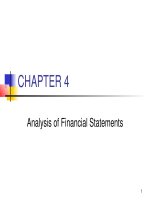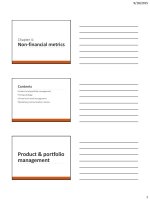Lecture Economics (19/e) - Chapter 4: Elasticity
Bạn đang xem bản rút gọn của tài liệu. Xem và tải ngay bản đầy đủ của tài liệu tại đây (299.7 KB, 16 trang )
04
Elasticity
McGrawHill/Irwin
Copyright © 2012 by The McGrawHill Companies, Inc. All rights reserved.
Price Elasticity of Demand
• Measures buyers’ responsiveness to
•
•
LO1
price changes
Elastic demand
• Sensitive to price changes
• Large change in quantity
Inelastic demand
• Insensitive to price changes
• Small change in quantity
4-2
Price Elasticity of Demand Formula
• Formula for price elasticity of demand
Ed =
LO1
Percentage Change in Quantity
Demanded of Product X
Percentage Change in Price
of Product X
4-3
Price Elasticity of Demand Formula
• Use the midpoint formula
• Ensures consistent results
Ed = Change in quantity ÷
Sum of quantities / 2
LO1
Change in price
Sum of prices / 2
4-4
Price Elasticity of Demand Formula
• Use percentages
• Unit free measure
• Compare responsiveness across
•
LO1
products
Eliminate the minus sign
• Easier to compare elasticities
4-5
Interpretation of Elasticity of Demand
• Ed > 1 demand is elastic
• Ed = 1 demand is unit elastic
• Ed < 1 demand is inelastic
• Extreme cases
• Perfectly inelastic
• Perfectly elastic
LO1
4-6
Extreme Cases
P
D1
Perfectly
inelastic
demand
(Ed = 0)
0
Perfectly inelastic demand
LO1
4-7
Extreme Cases
P
D2
Perfectly
elastic
demand
(Ed = ∞)
0
Perfectly elastic demand
LO1
4-8
Total Revenue Test
• Total Revenue = Price x Quantity
• Inelastic demand
• P and TR move in the same
•
LO2
direction
Elastic demand
• P and TR move in opposite
directions
4-9
Summary of Price Elasticity of Demand
Price Elasticity of Demand: A Summary
Absolute Value
of Elasticity
Coefficient
Demand Is
Impact on Total Revenue of a:
Description
Price Increase Price Decrease
Qd changes by a
larger
percentage than
does price
Total revenue
decreases
Total revenue
increases
Greater than 1
(Ed > 1)
Elastic or
relatively
elastic
Equal to 1
(Ed = 1)
Unit or unitary Qd changes by
elastic
the same
percentage as
does price
Total revenue
is unchanged
Total revenue
is unchanged
Less than 1
(Ed < 1)
Inelastic or
relatively
inelastic
Total revenue
increases
Total revenue
decreases
LO2
Qd changes by a
smaller
percentage than
does price
4-10
Determinants of Elasticity of Demand
• Substitutability
• More substitutes, demand is more elastic
• Proportion of Income
• Higher proportion of income, demand is
more elastic
• Luxuries vs. Necessities
• Luxury goods, demand is more elastic
• Time
• More time available, demand is more elastic
LO1
4-11
Price Elasticity of Supply
• Measures sellers’ responsiveness to
price changes
• Elastic supply, producers are
responsive to price changes
• Inelastic supply, producers are not
responsive to price changes
LO3
4-12
Price Elasticity of Supply
• Formula to compute elasticity
• Es > 1 supply is elastic
• Es < 1 supply is inelastic
Es =
LO3
Percentage Change in Quantity
Supplied of Product X
Percentage Change in Price
of Product X
4-13
Cross Elasticity of Demand
• Measures responsiveness of sales to
•
•
•
change in the price of another good
Substitutes – positive sign
Complements – negative sign
Independent goods - zero
Percentage change in quantity demanded of product X
Ex,y =
Percentage change in price of product Y
LO4
4-14
Income Elasticity of Demand
• Measures responsiveness of buyers
•
•
to changes in income
Normal goods – positive sign
Inferior goods – negative sign
Percentage change
in quantity demanded
Ei =
Percentage change in income
LO4
4-15
Ex,y and Ei
Cross and Income Elasticities of Demand
Value of
Coefficient
Cross elasticity:
Positive (Ewz > 0)
Negative (Exy < 0)
Description
Quantity demanded of W changes in same
direction as change in price of Z
Type of Good(s)
Substitutes
Quantity demanded of X changes in
Complements
opposite direction from change in price of Y
Income elasticity:
Positive (Ei >0)
Quantity demanded of the product changes
in same direction as change in income
Normal or superior
Negative (Ei<0)
Quantity demanded of the product changes
in opposite direction from change in income
Inferior
LO4
4-16









